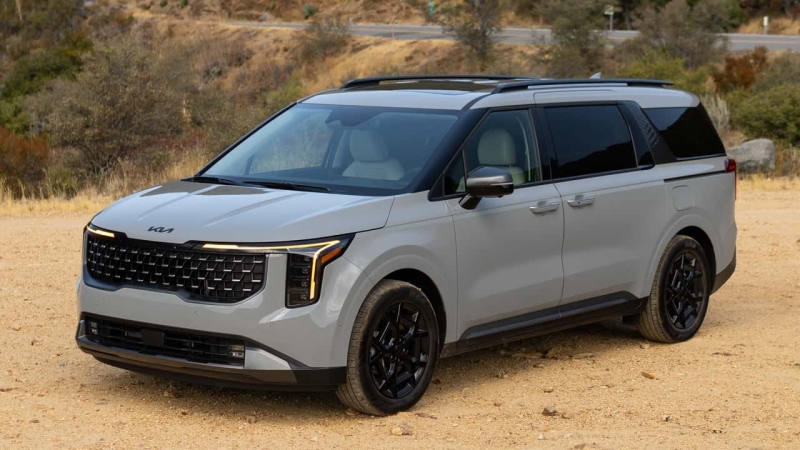The fuel cost savings alone are worth upgrading, even if Kia’s hybrid minivan isn’t as refined as Toyota’s.
Mack Hogan / Motor1
It’s silly not to offer a hybrid option for your minivan. Chrysler proved that concept with the Pacifica plug-in hybrid, and Toyota arguably perfected the art with the redesigned 2020 Sienna, available exclusively as a hybrid. Now Kia aims to disrupt that space with the luxurious and affordable 2025 Carnival HEV.
The Carnival HEV marks a serious improvement for Kia’s minivan, and it should help build considerable momentum for the brand. Since Kia introduced the Carnival as a Sedona replacement for 2022, sales have grown steadily. But last year, Carnival sales skyrocketed by 93%.
| Quick Specs | 2025 Kia Carnival Hybrid |
| Engine | Turbocharged 1.6-liter I4 Hybrid |
| Output | 242 Horsepower / 271 Pound-Feet |
| Fuel Economy | 34 City / 31 Highway / 33 Combined |
| Base Price / As-Tested |
$41,895 / $56,990 |
But the minivan segment is weird. Inertia runs deep. Chrysler, Honda, and Toyota occupy first, second, and third place in sales, respectively. But if you’re ranking them by which is best overall for most buyers, I’d argue you should read that list backward. Honda and Chrysler have a reputation for making the best vans, and not even Toyota can unseat those two stalwarts despite decades of attempts. Although Kia did point out that one of its competitors sells roughly 70% of its vans to fleets—I couldn’t possibly speculate which Chrysler van they might be talking about.
Kia has tried to disrupt the segment by pitching the Carnival as an SUV alternative. To some extent, it works. The Carnival has a tech-forward cabin with a new infotainment system that appeals to younger families. Lounge recliners fill the second row, there’s an available Highway Driving Assist 2 with lane keeping, sleek LED headlights, and cupholders designed to accommodate those 32-ounce Hydroflasks every millennial carries around.
The downside is the Carnival gets the same user interface as the Kia EV6, with a bar of capacitive buttons and real knobs that switch between controlling the infotainment and HVAC systems. Leave it in the wrong setting and you may find yourself turning up the temperature when you try to crank the music. It’s an annoying compromise for the sake of style and cost savings.
But as the “SUVs of minivans,” the Carnival is successful. It looks sleeker than any Toyota or Honda van. The cabin appears more expensive, despite a real-world price that’s thousands cheaper than a comparable Japanese or American van. Skip the rear-seat entertainment system and a top-shelf Carnival can be had in the low $50,000 range. Kia executives proudly point out that some competitors go up to nearly $60,000.
But the front-wheel-drive Sienna, my pick for the best van in the segment, tops out around where the Kia does. It’s only more expensive than the Carnival if you opt for all-wheel drive, which the Kia doesn’t offer.
Inside and out, the Carnival presents better. On the road, though, I’d rather have the Sienna. The Carnival’s 1.6-liter turbo four-cylinder hybrid powertrain eschews the much-derided continuously variable transmissions (CVTs) you find in most hybrids, including the sedan. Kia instead mates the engine to a conventional six-speed automatic.
That’s no problem in itself. But the promised benefit in smoothness and refinement doesn’t shake out in the real world. The powertrain is fine, if grumblier than the Sienna’s four-banger or any V-6 in the segment, but the tuning needs work.
Kia offers variable regen levels in the Carnival, adjustable via the steering wheel paddles in “Eco” and “Smart” mode. This ranges from no automatic regen to a near one-pedal experience, although as with most EVs, you can’t leave one-pedal mode on all the time. Unfortunately, the throttle pedal just isn’t a reassuring control.
There’s a noticeable lag between when you remove your foot and when you start to feel the regen kick. Tip-in is weird and hard to modulate. The brake pedal is worse, with a spongy top end that doesn’t seem to react linearly throughout a braking event. Holding my foot at roughly 30% braking force for a long stop, the amount of braking force the Carnival delivered changed 3-5 times over as many seconds. It’s a difficult van to drive smoothly.
The use of the paddles for regen control is also weird in a hybrid, because you can’t downshift on a steep grade in Eco or Smart modes. You have to go to Smart. That’s fine if you’re using regen to charge the car, but the tiny 1.5-kilowatt-hour battery fills quickly, after which no regen braking is available. The pedal then changes feel yet again.
All of these issues are less important on the highway. But there, Kia’s focus on making the Carnival SUV-like has downsides, too. There’s no driver right-side armrest, one of my favorite features in the Odyssey and Sienna for long-haul trips. There are fewer storage cubbies, too, even if there’s class-leading passenger and third-row cargo space. And while the Kia’s 31-mile-per-gallon highway rating is good, the Sienna’s 36-mpg figure is stellar. The Sienna is more efficient around too, with 36 mpg compared to the Carnival’s 34 mpg.
So the 2025 Carnival HEV lands at an odd spot. If you want a minivan with SUV-inspired styling and with the best tech features, it’s the best pick. But the Carnival’s focus on those things means it wouldn’t be my first pick for a road trip. I love minivans because I love having tons of storage cubbies, armrests to support my elbows on an eight-hour drive, a quiet, refined cabin, and space for everything. The Kia has many of those attributes, but it doesn’t surpass its rivals in any metric but space. I’ve never been lacking for space in any row of a Sienna or Odyssey, and those are still the vans I’d choose if I needed to take a road trip tomorrow.
Mack Hogan / Motor1
Competitors
- Chrysler Pacifica Hybrid
- Toyota Sienna
Get the best news, reviews, columns, and more delivered straight to your inbox, daily. Sign up For more information, read our
Privacy Policy and Terms of Use.
2025 Kia Carnival HEV
Engine Turbocharged 1.6-liter I4 hybrid
Motor Electric Permanent Magnet Synchronous
Battery 1.5-Kilowatt-Hour Lithium-Ion
Output 242 Horsepower / 271 Pound-Feet
Transmission Six-Speed Automatic
Drive Type Front-Wheel Drive
Weight 4,967 Pounds
Efficiency 34 City / 31 Highway / 33 Combined
Seating Capacity 7 / 8
Towing 2,500 Pounds
Cargo Volume 40.2 / 145.1 Cubic Feet
Base Price $41,895
As-Tested Price $56,990
On Sale Now



